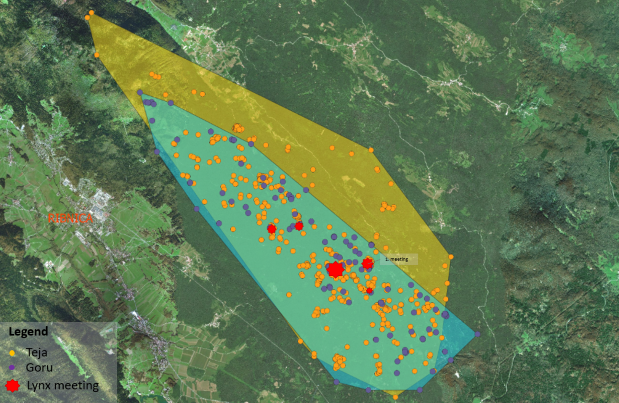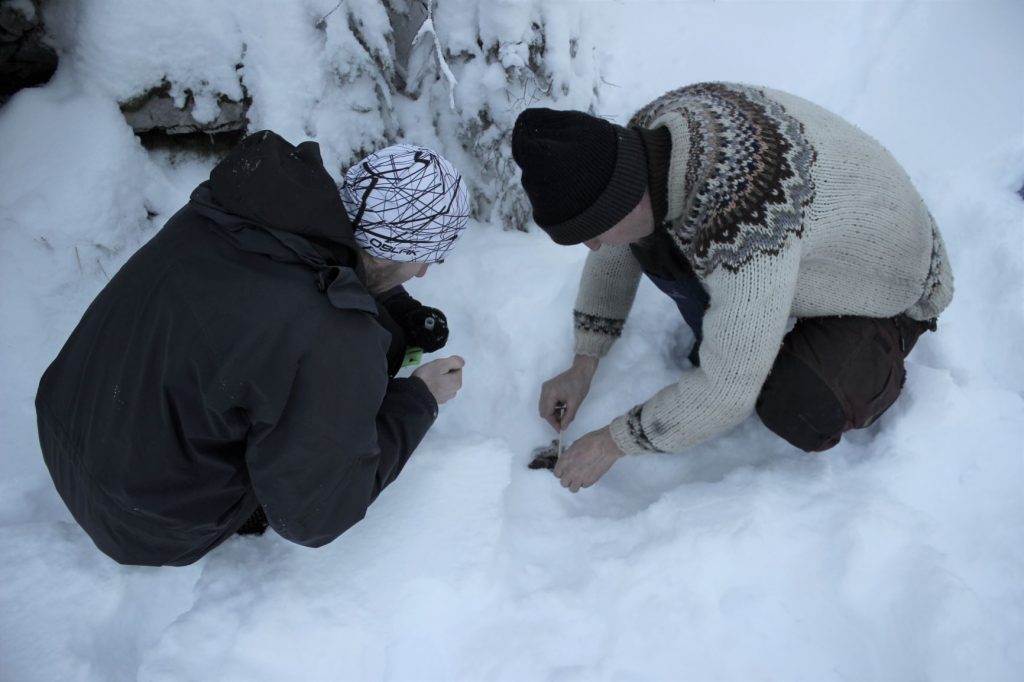5.1.2020 New photos of Teja, Goru and the kitten
Our photo traps on Mala Gora captured these amazing photos of lynx Teja, her kitten and Goru. Goru and the kitten were photographed at the same location, just 4 minutes apart. We are still waiting for genetic analyses to confirm the paternity of the kitten.

We photographed Goru and the kitten at the same location, just 4 minutes apart. Photo: LIFE Lynx

Playful Teja and her kitten. Photo: LIFE Lynx

Teja and her kitten. Photo: LIFE Lynx

Teja and her kitten. Photo: LIFE Lynx
24.12. 2019 Camera trapping photos reveal the behavior of Goru, Teja and the kitten
On December 21st we found a lynx prey in the Struge area (Slovenia) and decided to set camera traps there. We photographed lynx Teja and her kitten, while feeding on the prey. After we collected the cameras, we decided to move the camera traps about 500 m away to a nearby location, where we have photographed lynx Teja in the past. But this time Teja hasn’t returned, but we managed to photograph lynx Goru. We also found a neatly buried lynx scat nearby, which we assume is Goru’s.

Lynx Goru. Photo: Franc Kljun
10.9.2019 Lynx Goru was cough on camera trap
Goru and Doru have settled down nicely and established their territories in Slovenia. LIFE Lynx project team is in collaboration with local hunters, regularly collecting data about Goru’s and Doru’s prey. With this method we are collecting data about their prey selection, gender and age distribution. Sometimes we are also setting automatic cameras to see if the lynx will return to his prey. This enables us to check on his physical fitness and we also get data about other animals feeding on lynxes prey, like foxes, bears, wild boars, etc. We managed to get a good video of Goru, when he returned to his prey.
Video credit: Lan Hočevar, Biotechnical Faculty, Forestry department, LIFE Lynx
26.8.2019 Doru established his territory
Telemetry data from Doru’s radio collar show that he probably established a territory in Javorniki, moving in the area of around 90 km2.. The most northwestern part of his territory is determined by Highway A1 Ljubljana-Koper, which unfortunately doesn’t have specially established wildlife crossings and has been a big obstacle for lynx dispersal towards the west.

22.7.2019 Lynx dating
It looks like that our Romanian male lynx Goru has found his territory on Mala gora and maybe also his mate. He met a female lynx Teja, and it looks like they have met more than once. Their radio collar data shows that they first met on June the 1st, that is the first day Goru entered Teja’s territory. Their locations show that they’ve spent 3 days close to one another. Their second “date” was just after 4 days, when again they’ve spent 3 days in the same place. Afterwards we’ve searched this location and found the remains of a prey (female and juvenile roe deer), that they have obviously shared. We cannot say who caught the prey, because they got there practically at the same time. After their 3-day “lunch” they’ve separated and were moving independently for most of the time. On June 19th they’ve came back together for a day rest and on July 2nd for a brief encounter in the middle of the night. You can see their movements on the map we’ve prepared.

Territories of Goru (blue-green) and Teja (yellow). Stars indicate their meeting.
4.6.2019 Goru and Teja
Goru is still on the move, showing no signs of settling down. After visiting Notranjska Regional Park, he turned north and reached Ljubljana moors near Borovnica. There he turned towards east, crossing Rakitna and Iška and moving towards Grosuplje. Near Turjak he managed to kill his second roe deer since his release in Slovenia and was feeding on it for four days. Then he started moving south, passing by Ambrus and Ribnica. Currently, he is on Mala Gora, inside the territory of resident female lynx named Teja, which was radio-collared by the LIFE Lynx team earlier this year.

Goru’s movements from Cerknica to Mala gora (Ribnica).
21.5.2019 Goru’s movements after release and his first successful hunt
Goru was the first Eurasian lynx from Romania translocated to Slovenia and released into the wild near Slovenian-Croatian border on 14th May. Soon after release he crossed border to Croatia and clearly showed that lynx don’t care much about human-created borders. This is another indication why international cooperation is so important in projects like this.
Telemetry data sent by Goru’s GPS collar revealed that soon after arrival to Croatia his movement stopped. For Eurasian lynx this usually means that a successful hunt took place. We visited the location in Gorski Kotar and with the help of local hunter soon found lynx prey remains. Goru managed to make his first successful kill in Dinaric forests – a yearling female roe deer. We deployed automatic camera near the prey remains to monitor the consumption process. Lynx was feeding on his prey for several days, as is typical for this species. In the meantime also red fox visited the carcass for a free lunch. You can check the videos following these links:
After Goru finished with feeding, he returned to Slovenia, moving for 23 km to the Notranjska regional park near town Cerknica. We are now looking forward to receive new telemetry data, which might already indicate, if Goru is starting to settle down in this region, or if he will continue moving in search of his new territory.

Lynx Goru after the release.

Goru’s first kill in Dinaric forest – a yearling female roe deer. We are grateful to Bruno Brovet (on photo) and Giulia Bombieri for their help to locate prey remains. Photo: Miha Krofel, LIFE Lynx
19.2.2019 Snow tracking of the remnant lynx in Slovenian forests
During these winter months, project partners from Department of Forestry at Biotechnical Faculty and Slovenia Forest Service regularly conduct systematic winter snow trackings of the remnant lynx population in Slovenian forests. We search for lynx footprints across Notranjska and Kočevska regions and so far we have been able to locate lynx tracks on Mt. Snežnik, Javorniki, Racna gora, Hrušica, Stojna, Mala gora and Velika gora. Snow-tracking helps us to identify areas were the last surviving lynx are still present and show us paths they use. Footprints also often lead us to the locations, where lynx marked their territory, which enables us to collect non-invasive genetic samples from urine in the snow. This data will help us choosing optimal sites for future releases of lynx translocated from the Carpathian population, as well as to understand how much the inbreeding levels will be reduced following population reinforcement efforts during the project.

Snowy lynx tracks. Photo: Miha Krofel

Collecting part of lynx scat for genetic analysis. Photo: Urša Fležar

We also found bear scats. Photo: Urša Fležar

Lynx and wolf footprint. Photo: Urša Fležar
18.2.2018 On the lynx track
This winter we are intensively collecting non-invasive genetic samples of lynx in Slovenia in Croatia. This will help us to determine the most suitable areas for future releases of lynx that will be translocated from the Carpathian Mountains in order to prevent extinction of our endangered population, which is suffering from critical level of inbreeding. Easiest way to collect lynx genetic samples, such as scats, hair, urine or saliva, is by snow-tracking. But finding lynx track is not always easy, especially now when deep snow limits the area we can cover.
This weekend we went looking for lynx tracks on Racna gora near Slovenian-Croatia border. I was joined by my friend, Ruben Portas, a IZW researcher from the Cheetah Research Project in Namibia, who is currently visiting us in Slovenia. After several hours of checking animal tracks we found fresh lynx footprints and followed them until dark. We could see how lynx was spreading her feet to reduce sinking in deep snow. At two sites we found lynx hair, which will now be used for genetic analysis in order to identify the lynx. Snowing during the night prevented us to continue with tracking the lynx the following day, so we are now waiting for weather to stabilize again and enable us to go back to the Dinaric forests searching for the tracks of the largest cat in Europe.
Snow tracking on Racna gora. Photo: Miha Krofel

Collecting lynx hair for genetic analysis. Photo: Ruben Portas
